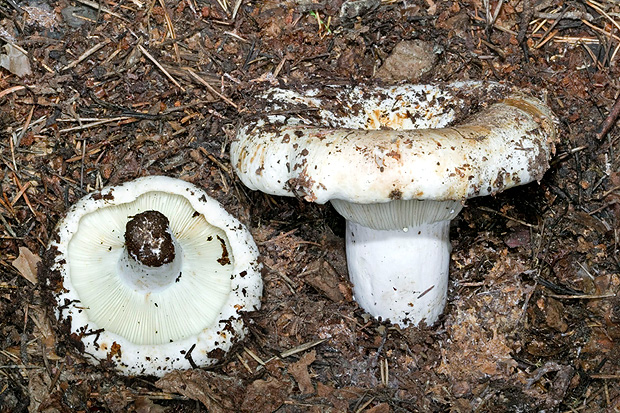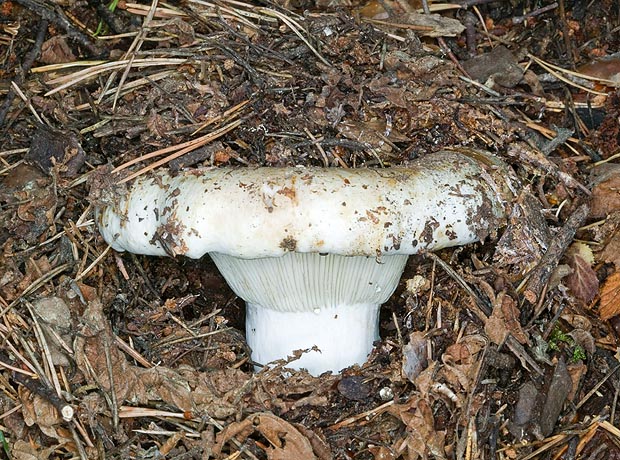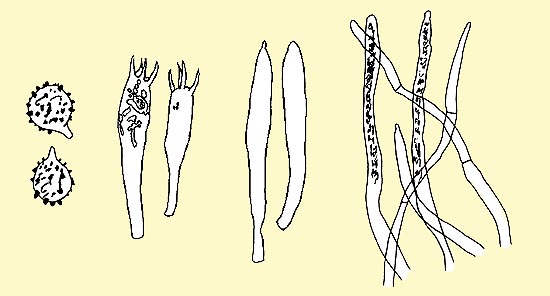
Text © Pierluigi Angeli

English translation by Mario Beltramini

The Russula delica cap, hemispheric then convex, finally funnel-shaped, measures 5-10 cm © G. Mazza
Family: Russulaceae Lotsy, 1907.
Genus: Russula Persoon : Fries, 1821.
Subgenus: Compactae (Fries) Bon, 1986.
Section: Lactarioides (Bataille) Konrad & Josserand, 1934.
Russula delica Fries, 1838.
The name comes from the Latin “délicus” = without milk, devoid of milk, due to the absence of latex.
Commonly known under the names of: “colombina bianca”, “rossola delicata”, “durello”, “peperone”, in Italy; “russule faux-lactaire”, “russule sans lait”, “prévat”, in France; “rúsula blanca”, “pebrás”, “gibelzuri orrizabal” in Spain; “Whitish russula” in English speaking countries; Blaublättriger”, “Weisstäubling”, “Gewöhnlicher”, in Germany.
Description of the Subgenus and Section
To the subgenus Compactae are ascribed taxa characterized by firm and compact flesh, dry cap, from white or whitish, initially, to bister brown finally to blackish; smooth margin, not grooved, little inrolled in the young fungus, then straight; hymenophore with numerous lamellulae of variable length. Spore print mostly white, but also cream or yellow. Spores are mostly with non-amyloid supra-hyphal notch.
In the Section Lactarioides are grouped taxa which characterize for the cap, initially convex, then depressed or crateriform, with rough surface, initially white or whitish, then rusty; very short stem and flesh darkening when cut. Spore print from cream to yellow. The spores have partially amyloid supra-hyphal notch.
Description of the species
Cap: 5-15 cm, initially hemispheric, then convex, bun liken umbilicate, finally flattened, depressed up to crateriform or funnel-shaped; margin initially inrolled for long time, then straight, thin, undulated, lobed, not grooved; dry surface, rugged, opaque, also little felted, initially white, then with ochre or brownish dots, almost completely covered by mould and leaves which it traps when it comes out from the soil in the growth.

It grows from spring to late autumn in calcareous and dry deciduous or conifer woods © Giuseppe Mazza
Hymenium: moderately spaced gills, adnate or just decurrent, wide, thick, rigid and frail in the mean time, rather uneven, inconstantly forked, intercalated by variously long lamellulae; whitish, cream, rust-spotted, concolorous, entire, edge.
Stem: 2,5-5 x 1,5-3,5 cm, cylindroid, short and stocky, expanded from bottom to top, compact, hard, full, then spongy; the surface is rather pruinose, rugged, white, then with brownish spots.
Flesh: thick, compact, frail, from compact to spongy and often wormy in the stem; white, tends to become brown when cut. Smell of fish, of salt or of fruit, tending to have one prevailing on the other; mild taste on the flesh, somewhat spicy on the gills.
Habitat : it grows in small groups, from spring to late autumn, in latifolious woods as well as in the conifer ones, in calcareous and dry soils.
Edibility: mediocre edible, it is not appreciated due to the poor supply of flavour. We feel obliged to express our personal opinion on the gastronomic value of this fungus, even if we know that it is much sought for and eaten in some zones; however, we realize that this belongs to a gastronomic and cultural tradition worthy of attention.
Chemical reactions: it gives a rapid reaction to the dark green, on the flesh, to the Guaiacum tincture; it gives a slow reaction to the pale pink, on the flesh, to the ferrous sulphate (FeSO4).
Microscopy: ovoid, sub-globose spores, echinulate with obtuse prickles, often cristate-catenulate with some thin connexion, 8-11 x 7-9 µm, little amyloid supra-hyphal notch. Clavate basidia, tetrasporic, without joint buckles, 52-60 x 11-13 µm. Cylindroid cystidia, fusiform, with obtuse or appendiculate apex, 68-150 x 8- 12µm. Cuticle with cylndroid hairs, septate, with rounded apex; cylindroid dermatocystidia, with few septa, becoming grey in sulphovanilline (SV).
Remarks. Russula delica is a quite diffused species and common under latifolious trees and also under coniferous ones in calcareous soils, from the Mediterranean to the sub-Alpine zones.

Russla delica: spores, basidia, cystidia, cuticle hairs and dermatocystidia © Pierluigi Angeli
It quite easily recognized due to the rather big size, the spaced and broad gills, the shape of the rather irregular cap, the fruity smell, especially when young, becoming unpleasant in the adult individual and the just peppery flavour.
It may be mistaken with several species: Russula chloroides (Krombholz) Bresadola, which, however, has thicker and narrower gills with green-grey hues, the more regular and funnel-shaped cap, the reaction to the FeSO4 slowly orange pink, to the Guaiacum slowly green; Russula pallidospora Blum ex Roamgnesi, which, however, has the gills ochre yellow, with orange hues in the ripe fungus, the spore print strong cream, the taste refreshing but typically sour and astringent, but not spicy, the reaction to the FeSO4 reddish, orange pink, to the Guaiacum strong and rapid; Russula flavispora Blum ex Romagnesi, which, however, has the gills from ochre cream to yellowish, complex disgusting smell, sour taste, burning, the reaction to the FeSO4 orange pink, to the Guaiacum violent and rapid to the blue, to the Phenol slowly brownish; Russula delica var. puta Romagnesi, which, however, has thicker and narrower gills, without any blue hue, quite thin margin, mild taste and reticulate spores, the reaction to the Guaiacum positive.
Other possible confusions may happen with some species of the Genus Lactarius, for the habitus and the colour of the carpophore: Lactarius piperatus (Linnaeus: Fries) Persoon, which, however, has very thick and narrow gills, the stem normally slender, when broken it secretes a thick and white latex; Lactarius glaucescens Crossland, which, however, has thick, narrow gills, cream-whitish suffused of flesh colour, the flesh turning slowly to greyish green, then to intense green, white latex which becomes green when drying; Lactarius vellereus (Fries : Fries) Fries, which, however, has narrower gills, of yellowish cream colour, spotted of brownish cream, flesh with acidulous smell and sour taste, secretes a little abundant latex, white, becoming brownish cream when dries up on the gills.
Synonyms: Omphalomyces crassus Battarra 1759; Hypophyllum album Paulet 1808; Russula delica var. bresadolae Singer 1938; Lactarius exsuccus (Persoon : Fries) W.G. Smith 1873.
→ For general notions about Fungi please click here.
→ To appreciate the biodiversity of MUSHROOMS please click here.
